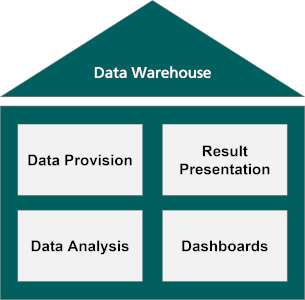Definition Business Intelligence System
What is a Business Intelligence System?
A Business Intelligence System (BI) covers the process of collecting, analyzing and processing data into usable information and their presentation. For this purpose, it comprises a variety of tools, applications and methods that enable the company to collect, prepare and analyse information from internal systems and external sources. Collected data can be stored detached from operative systems in a data warehouse, not only to create a uniform data basis for analyses, but also to avoid slowing down operative systems through data-intensive evaluations.
The information obtained is made available to decision-makers and company employees in visual form in reports and dashboards. In this way, BI can be used to provide key figure-based decision support both for ongoing business processes and for strategic decisions.
On this basis, parts of the company can be optimised, profitability and sales increased and productivity improved. Furthermore, operational efficiencies can be increased and future market trends can be identified. Thus, the use of BI can help companies to gain a competitive advantage.
Business Intelligence vs. Business Analytics
Business Analytics answers questions relating to why events have occurred and how they behave in response to exogenous changes. Static and quantitative analyses as well as data mining and forecast modelling are used for this purpose. In contrast to this, Business Intelligence describes the events that have occurred, as well as the time and origin of their occurrence. The tools used for this purpose include information from reports such as KPIs and metrics, dashboards, scorecards or ad hoc queries.
Functionality of a BI

The majority of BI users want a customisable solution, i.e. the BI should be adaptable to individual business processes without being an (expensive) individual solution. The providers try to meet this demand by developing systems that can be parameterised (by the customer) and have defined program routines that integrate individually adaptable functions into the system.
A standard BI has all the functions necessary for collecting, evaluating and displaying data. The Fraunhofer IML counts the core functions including the functional support of data storage, evaluation and presentation.
Basically, the user defines the scope of the BI. Any function that the user deems necessary is part of his BI.
Core Functions
The core functions belong to the ordinary functional area of each RPS. They are indispensable for the operation of the RPS and belong to the minimum installation scope of each system. A few core functions, e.g. Data Warehouse, are also offered separately by specialists as independent modules. Normally, however, the core functions are only supported by modules of the BI supplier. The core functions support the main area of application of each BI: From data collection to the presentation of results.
